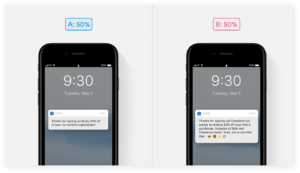Thorough testing and analysis is key to gaining a greater understanding of users’ behavior. It’s this understanding that helps to pave the way for improvements in marketing campaigns, enabling marketing professionals to learn from users’ past behavior and tweak interactions to appeal to the specific preferences of target audiences.
Marketers use test groups to study how users interact with their campaigns, and control groups too have an important role to play. Read on to find out more about how these groups differ and learn how they can be used to ensure the accuracy of test results.
Test Group vs Control Group
The terms test group and control group might sound deceptively similar, but they are in fact two completely different ideas – and they’re both vital if a marketing test is to be run effectively. Let’s define what we mean by test group and control group to explain why every marketing test should involve the use of both.
What is a Test Group?
A test group is the name given to the entire group of users who will be analyzed as part of a study. So, if you’re running a mobile A/B test and the variables are being sent to a set proportion of users, your test group will be the total number of users being sent either variable.
It doesn’t matter how many variables you’re testing, or how long your tests are running for. The test group will remain throughout the study, and the number of users whose interactions are being measured should not change from the start of the study to the end.
Test groups shouldn’t just contain segments of users being sent different variables, though. Do this and you run the risk of confirmation bias in your results. To ensure the accuracy of any test, the test group should always contain what’s known as a control group.
What is a Control Group?
A control group is a group of users for whom content and interactions remain unchanged throughout a test. By creating such a group and measuring the interactions of this group throughout the study, marketers can start to understand how different variables may have changed their results. Without a control group, it’s impossible to confirm the real impact of any variables being tested.
Control groups are used in many different areas of research. Take drug trials, for example. In every drug trial, there will be a group of people who do not receive any of the drugs being tested. Instead, they’ll be given a placebo. This allows researchers to study the results of any drugs that were tested, and compare them to a scenario in which participants received no treatment. A control group works in exactly the same way.
So, why and how should marketers use a control group?
There are many reasons why marketers might choose to introduce a control group into their research. Control groups are particularly important in A/B testing and multivariate testing, as they help to ensure the results of such tests are as accurate as they can possibly be. Take a look at some of the main uses of control groups for marketing professionals below.
Control groups in A/B & Multivariate testing
In A/B and multivariate testing, a control group is a must. Whether the test is focused on a website design tweak, changes to copy, different imagery, or a new way of presenting a call to action, it’s vital that test groups also contain a control group for the duration of the analysis.

When the testing period ends and results are analyzed, a control group can be used to establish how users would have behaved had no changes been implemented. By comparing these results against the results of the different variables, marketers will easily see what impact their changes have had.
Segmentation
Segmentation is an important consideration when creating any marketing test, and it’s worth thinking about when it comes to creating different test groups and control groups too.
In order to maintain the accuracy of a test, it’s crucial that users are segmented appropriately. Control groups should contain similar users to groups being sent different variables. If the characteristics of users are significantly different across these groups, then the results of any test could be misleading.
When not to use a control group
While control groups are integral to the accuracy of a wide range of different tests, they’re not recommended for use in every campaign. In some circumstances, the use of a control group won’t bring any real benefits.
For example, if a business decides to run a reminder campaign, or wants to create an educational campaign designed to boost awareness, there’s little point in adding a control group into the mix. In some cases, the results of a new campaign strategy can’t be tracked through existing analytical tools, so the use of a control group wouldn’t be recommended here either.
Understanding the difference between a test group and a control group can make a real difference to the effectiveness of your tests. Start including control groups in your campaign analysis to gain the best possible understanding of your audience’s preferences.
If you’d like to learn more about how to use control groups to give your business the edge over its competitors, get in touch with our team.
To learn more about what Leanplum can do for your team, check out these resources:
- Read the Just Eat Takeaway.com Case Study to see how Just Eat Takeaway.com achieved a 17% increase in total order volume
- Read our article Ten Tips to Supercharge User Engagement
- Watch our full session with Popsa, From Batch and Blast to Personalization at Scale to learn how mobile-first companies optimize engagement, experience and revenue
- We are the only engagement platform with a focus on Subscription Apps and On-Demand & Mobile Retail
- Check out the Product Tour to see Leanplum in action
- Set up a complimentary personalized demo of Leanplum
—
For app-first companies, Leanplum is the only solution that helps personalize and optimize all customer touchpoints, both inside and outside the app. Leanplum combines multi-channel Lifecycle Marketing with the ability to A/B test the Product Experience for complete, end-to-end personalization of the mobile journey. Break down organizational silos and eliminate point solutions to enable rapid growth.




